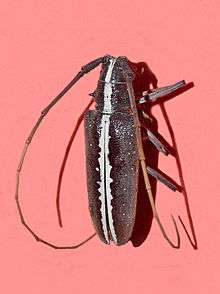Taeniotes scalatus
Taeniotes scalatus is a species of flat-faced longhorn beetle in the subfamily Lamiinae of the family Cerambycidae.[1]
| Taeniotes scalatus | |
|---|---|
 | |
| Museum specimen of Taeniotes scalatus | |
| Scientific classification | |
| Kingdom: | |
| Phylum: | |
| Class: | |
| Order: | |
| Suborder: | |
| Superfamily: | |
| Family: | |
| Subfamily: | |
| Genus: | |
| Species: | T. scalatus |
| Binomial name | |
| Taeniotes scalatus (Gmelin, 1790) | |
| Synonyms | |
| |
Description
Taeniotes scalatus can reach a length of 30–40 millimetres (1.2–1.6 in). Basic color of body is black, with a yellow dorsal streak and small spots. Larval host plants are cultivated figs (Ficus carica), Artocarpus altilis, Artocarpus integrifolia, Brosimum utile, Castilloa elastica, Morus alba and Coffea arabica.[2] These nocturnal flat-faced longhorn beetles can be found all year round, especially from March to June.[3]
Distribution
This species is very common and widely distributed in Azores and in Nearctic ecozone, in Mexico, in Central America (Belize, Bolivia, Costa Rica, Colombia, Equator, Guatemala, Honduras, Nicaragua, Panama and Venezuela).[1][2][4][5][6]
Bibliography
- Miguel A. Monné (2005): Catalogue of the Cerambycidae (Coleoptera) of the Neotropical Region. Part II. Subfamily Lamiinae
- Tavakilian, G. and Chevillotte, H. (2012) Titan: base de données internationales sur les Cerambycidae ou Longicornes.
External links
References
- Biolib
- Monné MA, & CS Chaboo. 2015. Beetles (Coleoptera) of Peru: A survey of the Families. Cerambycidae, Disteniidae, Vesperidae. Journal of the Kansas Entomological Society 88(1): 34-120.
- Lasse Hubweber Longhorn beetles (Coleoptera, Cerambycidae) of the Golfo Dulce region, Costa Rica
- Fauna europaea
- Miguel A. Monné, and Larry G. Bezark Checklist of the Cerambycidae of the Western Hemisphere
- Catalogue of life